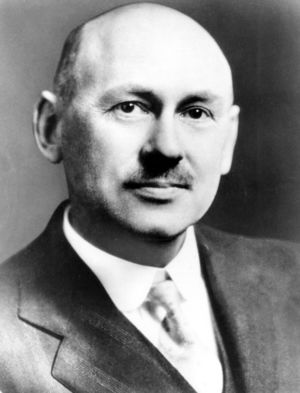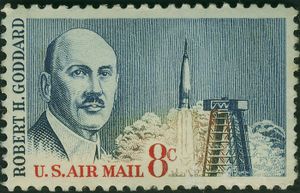روبرت هـ. گدارد
روبرت هتشينگز گدارد Robert H. Goddard | |
|---|---|
 روبرت هتشينگز گدارد (1882-1945) | |
| وُلِدَ | أكتوبر 5, 1882 |
| توفي | أغسطس 10, 1945 (aged 62) |
| المهنة | مهندس |
| السيرة الهندسية | |
| تقدم بارز | صواريخ ذات الوقود السائل متحكم فيها |
روبرت هتشينگز گدارد Robert H. Goddard (و.1882 - 1945م). رائد علم الصواريخ الأمريكي. قادته تجاربه في مجال الصواريخ ذات الوقود الصلب والسائل بين عامي 1909 - 1945م إلى تطوير مغذِّ للطاقة للقذائف عابرة القارات والسفن الفضائية. ولم تُعرف قيمة اختراعاته في مجال الصواريخ إلاّ بعد وفاته.
ولد جودارد في ووستر، مساتشوستس. بدأ يدرس إمكانية إطلاق الصواريخ، عندما كان طالبًا في المعهد التطبيقي في مسقط رأسه. واصل دراسته في هذا المجال في جامعة كلارك حيث حصل على درجة الدكتوراه عام 1911م منها ثم انضم إلى هيئة التدريس في الجامعة نفسها عام 1914م.
تلقى جودارد دعمًا متواضعًا على أبحاثه من معهد سميثسونيان. وفي عام 1919م نشر تقريره التقليديّ "طريقة الوصول إلى أقصى ارتفاع" في مجموعات معهد سميثسونيان المتنوعة. وصف جودارد في تقريره نوع الرحلة الصاروخية الضرورية للوصول إلى القمر. وقوبلت مقالته بتعليقات تدل على عدم التصديق، من قبل الصحافة، مما جعله يتوقف عن النشر، لكنه استمر في عمله دون ذكر اسمه.
أول إطلاق بوقود سائل

تسلّم مبلغًا كافيًا لتمويل بحثه المتعلّق بتصميم وإنشاء أول صاروخ يعمل بالدفع السائل. بدأ مشروعه في مزرعة لأحد أقربائه قرب أوبورن، مساتشوستس. وأتاح له نجاحه الحصول على تمويل إضافي لبحثه المتعلق بدفع الصاروخ.
روزويل، نيو مكسيكو

وفي عام 1930م أطلق جودارد بنجاح عدة صواريخ ذات حجم أكبر تعمل بالوقود السائل. كما قدم إسهامات أساسية فيما يتعلق بتطوير مضخات الدفع وأدوات التحكم في أجهزة التوازن وأنظمة الإبقاء على الوضع الأفقي. وقام خلال الحرب العالمية الثانية (1939- 1945م) بأبحاث لصالح الأسطول الأمريكي حول المحركات الصاروخية للإقلاع بمساعدة الدفع النفاث للطائرات.
| Date | Type | Altitude in feet | Altitude in metres | Flight duration | Notes |
|---|---|---|---|---|---|
| December 30, 1930 | Goddard 4 | 2000 | 610 | ? | record altitude |
| September 29, 1931 | Goddard 4 | 180 | 55 | 9.6 s | |
| October 13, 1931 | Goddard 4 | 1700 | 520 | ? | |
| October 27, 1931 | Goddard 4 | 1330 | 410 | ? | |
| April 19, 1932 | - | 135 | 41 | 5 s | |
| February 16, 1935 | A series | 650 | 200 | ? | |
| March 8, 1935 | A series | 1000 | 300 | 12 s | |
| March 28, 1935 | A series | 4800 | 1460 | 20 s | record altitude |
| May 31, 1935 | A series | 7500 | 2300 | ? | record altitude |
| June 25, 1935 | A series | 120 | 37 | 10 s | |
| July 12, 1935 | A series | 6600 | 2000 | 14 s | |
| October 29, 1935 | A series | 4000 | 1220 | 12 s | |
| July 31, 1936 | L series, Section A | 200 | 60 | 5 s | |
| October 3, 1936 | L-A | 200 | 60 | 5 s | |
| November 7, 1936 | L-A | 200 | 60 | ? | |
| December 18, 1936 | L series, Section B | 3 | 1 | ? | Veered to horizontal immediately after launch |
| February 1, 1937 | L-B | 1870 | 570 | 20.5 s | |
| February 27, 1937 | L-B | 1500 | 460 | 20 s | |
| March 26, 1937 | L-B | 8000-9000 | 2500-2700 | 22.3 s | Highest altitude achieved |
| April 22, 1937 | L-B | 6560 | 2000 | 21.5 s | |
| May 19, 1937 | L-B | 3250 | 990 | 29.5 s | |
| July 28, 1937 | L-series, Section C | 2055 | 630 | 28 s | |
| August 26, 1937 | L-C | 2000 | 600 | ? | |
| November 24, 1937 | L-C | 100 | 30 | ? | |
| March 6, 1938 | L-C | 525 | 160 | ? | |
| March 17, 1938 | L-C | 2170 | 660 | 15 s | |
| April 20, 1938 | L-C | 4215 | 1260 | 25.3 s | |
| May 26, 1938 | L-C | 140 | 40 | ? | |
| August 9, 1938 | L-C | 4920 (visual) 3294 (barograph) |
1500 1000 |
? | |
| August 9, 1940 | P-series, Section C | 300 | 90 | ? | |
| May 8, 1941 | P-C | 250 | 80 | ? |
V-2
هناك قصة يكثر ترديدها، مصدرها گدارد نفسه، ومفادها أنه في نهاية الحرب العالمية الثانية شاهد گدارد حطام الصاروخ الباليستي V-2 الألماني واقتنع أن الألمان قد سرقوا عمله. وبالرغم من أن گدارد قد فحص صاروخ V-2، إن هناك لبس حول كيفية الحصول على ذلك الصاروخ وكذلك مدى تأثير گدارد على تصميمه.
في ربيع 1945 Goddard saw a captured German V-2 ballistic missile which had been sent to the naval laboratory in Annapolis, Md. where Goddard had been working under contract. It is not out of the question that parts were despatched to Goddard in Annapolis, but there would not have been much time: Goddard died of throat cancer in August 1945.
One opinion, described in the May 1959 issue of Popular Science[1] would have it that the V-2 which he inspected was wreckage retrieved from a test flight that had crashed in Sweden (the so-called قنبلة باكبو). This wreckage had been analyzed and reconstructed by British (not US) engineers at Farnborough from July 1944 as part of Project Big Ben.
Another view is that this was not the wreckage from Sweden, but an unlaunched rocket that had been captured by the US Army from the Mittelwerk factory in the Harz mountains. Samples captured here were first shipped back by Special Mission V-2 on 22nd May 1945.[2]
After a thorough inspection Goddard was convinced that the Germans had "stolen" his work. Though the design details were not the same, the basic design of the V-2 was similar to one of Goddard's rockets. The V-2, however, was technically far more advanced than the most successful of the rockets designed and tested by Goddard. The Peenemünde rocket group led by Wernher von Braun may have benefited from the pre-1939 contacts to a limited extent, but had also started from the work of their own space pioneer, هرمان اوبرث; they also had the benefit of intensive state funding as a war project, large-scale production facilities (using slave labor), and repeated flight testing that allowed them to refine their designs. Nonetheless, in 1963, von Braun, reflecting on the history of rocketry, said of Goddard: "His rockets...may have been rather crude by present-day standards, but they blazed the trail and incorporated many features used in our most modern rockets and space vehicles".[3]
كتمان گدارد
Goddard avoided sharing details of his work with other scientists, and preferred to work alone with his technicians. فرانك مالينا, who was then studying rocketry at the معهد كاليفورنيا للتكنولوجيا, visited Goddard in August of 1936. Goddard refused to discuss any of his research, other than that which had already been published in Liquid-Propellant Rocket Development. Theodore von Kármán, Malina's mentor at the time, was unhappy with Goddard's attitude and later wrote, "Naturally we at Caltech wanted as much information as we could get from Goddard for our mutual benefit. But Goddard believed in secrecy.... The trouble with secrecy is that one can easily go in the wrong direction and never know it." Goddard's concerns about secrecy led to criticism for failure to cooperate with other scientists and engineers.
ذكراه

Goddard was awarded 214 patents for his work, 83 of which came during his lifetime.
The Goddard Space Flight Center, a NASA facility in Maryland, was established in 1959. الفوهة گدارد على القمر مسماة على اسمه تكريماً له.
منح جودارد بعد موته جوائز مادية ومعنوية كثيرة، كان منها ميدالية الكونجرس الذهبية، وميدالية لانجلي الذهبية.
تسجيل مرئي
انظر أيضاً
- ڤرنر فون براون
- كونستانتين تسيولكوڤسكي
- هرمان اوبرث
- دفع المركبات الفضائية
- پدرو پولت
- ڤيكرام سرباي
- صاروخ
الهامش
- ^ "The Man Who Opened the Door to Space". Popular Science. May 1959.
- ^ Ordway, Frederick I, III (1979). The Rocket Team. Apogee Books Space Series 36. New York: Thomas Y. Crowell. ISBN 1894959000.
{{cite book}}: Unknown parameter|coauthors=ignored (|author=suggested) (help)CS1 maint: multiple names: authors list (link) - ^ http://history.msfc.nasa.gov/vonbraun/recall.html
وصلات خارجية
- Time magazine profile of Robert H. Goddard
- FAQ on Goddard
- Lehman, Milton, This High Man: The Life of Robert H. Goddard, 1963
- Robert Goddard Wing of the Roswell Museum
- NASA.Robert H. Goddard: American Rocket Pioneer. Retrieved May 1, 2005.
- Dr. Robert H. Goddard Archives from Clark University
- TIME 100: The Most Important People of the Century (March 29, 1999)."Robert Goddard".
- New York Times; August 11, 1945; Pioneer in Field, Chief of Navy Research on Jet-Propelled Planes, Taught Physics Experimented Three Decades Secret Work During War. Baltimore, August 10, 1945 (AP) Dr. Robert H. Goddard, internationally known pioneer in rocket propulsion and chief of Navy research on jet-propelled planes, died today at University Hospital.
- A Tribute to R H Goddard--Space Pioneer
- NASA MSFC Goddard Rocket Replica Project
- CS1 errors: unsupported parameter
- Pages using infobox engineer with unknown parameters
- Portal templates with default image
- مواليد 1882
- وفيات 1945
- مهندسو طيران أمريكان
- أسقفيون أمريكان
- خريجو جامعة كلارك
- حائزو وسام الكونگرس الذهبي
- أشخاص من ووستر، مساتشوستس
- وفيات بسبب سرطان الحلق
- أشخاص من مساتشوستس
- علماء ارتياد الفضاء المبكرون
- علم الصواريخ المبكر
- مقالات تحتوي مقاطع ڤيديو
- وفيات بالسرطان في الولايات المتحدة

